Wildflowers, Grasses and Other Nonwoody Plants
Media
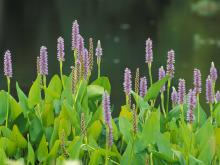
Species Types
Scientific Name
Pontederia cordata
Description
The handsome violet-blue flower spikes of pickerel weed stand out vividly at the edges of ponds. One of our few blue-flowering pond plants, pickerel weed is easy to identify by its color alone.
Media

Species Types
Scientific Name
Echinodorus berteroi
Description
A plant of shorelines and shallow water, tall burhead has clusters of beaked seeds that develop in the fall. Hundreds of these spiny seed heads, held in clusters above the water, make it distinctive.
Media
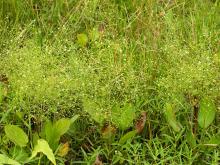
Species Types
Scientific Name
Alisma spp.
Description
With their whorl of oval leaves with thick, ridged stems, water plantains look like giant versions of the plantains that commonly appear in yards. Water plantains are water-edge plants that bear large, branching stalks of tiny white flowers.
Media
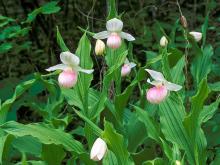
Species Types
Scientific Name
Cypripedium reginae
Description
Showy lady’s slipper is a beautiful and rare wildflower. This orchid can be more than 3 feet tall, with showy flowers with a pink-suffused, inflated lower lip. In Missouri, it's restricted to the southern portion of the Ozarks.
Media

Species Types
Scientific Name
Galearis spectabilis (formerly Orchis spectabilis)
Description
Showy orchis is a perennial wildflower of rich, moist, shady woods, slopes, ravines, and stream valleys, often found with other spring wildflowers. It’s about 6 inches tall when it produces its beautiful pink and white flowers.
Media

Species Types
Scientific Name
Packera glabella (formerly Senecio glabellus)
Description
Butterweed, one of Missouri’s seven species of ragworts or groundsels, is the only one that is an annual. It grows in colonies, at times covering acres of floodplain. Stems are heavily ridged and usually inflated or hollow. It blooms April–June.
Media
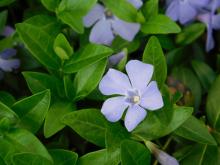
Species Types
Scientific Name
Vinca minor
Description
Common periwinkle is a low-growing, mat-forming, purple-flowering perennial that is woody at the base. Native to Eurasia, it is often grown as a groundcover. It has proven invasive in much of the eastern United States and frequently escapes from cultivation. Planting it is not recommended.
Media

Species Types
Scientific Name
Subfamily Asclepiadoideae
Description
Milkweeds are a group of plants that used to have their very own family. Now part of the dogbane family, they’re still a pretty distinctive group.
Media

Species Types
Scientific Name
Iris virginica
Description
Ten species of iris grow wild in our state, but only four of them are native. Of our native irises, this one is the most common. But drainage “improvements” are eliminating the habitat of this beautiful wetland wildflower.
Media
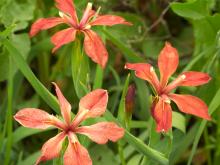
Species Types
Scientific Name
Iris fulva
Description
This attractive, copper-colored iris is gaining in popularity as a garden plant even though its numbers are declining in the wild. Like many other native plants, copper iris is hardy, low-maintenance, and has few pest or disease problems.
See Also
About Wildflowers, Grasses and Other Nonwoody Plants in Missouri
A very simple way of thinking about the green world is to divide the vascular plants into two groups: woody and nonwoody (or herbaceous). But this is an artificial division; many plant families include some species that are woody and some that are not. The diversity of nonwoody vascular plants is staggering! Think of all the ferns, grasses, sedges, lilies, peas, sunflowers, nightshades, milkweeds, mustards, mints, and mallows — weeds and wildflowers — and many more!





















